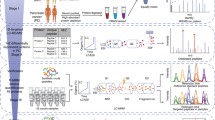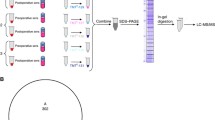Abstract
Purpose
Pancreatic ductal adenocarcinoma (PDAC) is one of the most lethal cancers worldwide and is difficult to detect at its early stages when treatment is most effective. Therefore, we performed a comparative proteomic study to identify new biomarkers for the detection of PDAC.
Methods
Serum samples from patients with PDAC, chronic pancreatitis and normal controls were compared using two-dimensional difference gel electrophoresis (2D-DIGE). Differentially expressed separated proteins were subsequently identified by matrix-assisted laser desorption ionization time-of-flight mass spectrometry (MALDI-TOF/TOF–MS). Then, transthyretin (TTR), one of the differentially expressed proteins, was validated through real-time PCR, western blot and immunohistochemistry. Finally, enzyme-linked immunosorbent assays (ELISA) were employed to confirm the levels of transthyretin in the sera.
Results
A total of 21 protein spots showed greater than 1.5-fold changes in expression level in the sera from PDAC patients compared with the normal controls. Among the identified proteins, validation experiments verified the differential expression of transthyretin in PDAC tissue, confirming the proteomic data showing that transthyretin was significantly elevated in patients with PDAC. The ELISA results revealed that the sensitivity and specificity for TTR and CA19-9 in distinguishing PDAC patients from normal individuals were 90.5, 47.6, 66.7 and 85.7 %, respectively, and 81.0 and 85.7 % for their combination.
Conclusions
These results suggest that the level of transthyretin is elevated in patients with PDAC. In combination with CA19-9, transthyretin may provide additional information for the detection of PDAC and should be further investigated.







Similar content being viewed by others
References
Bunger S, Laubert T, Roblick UJ, Habermann JK (2011) Serum biomarkers for improved diagnostic of pancreatic cancer: a current overview. J Cancer Res Clin Oncol 137:375–389
Chen R, Pan S, Aebersold R, Brentnall TA (2007a) Proteomics studies of pancreatic cancer. Proteomics Clin Appl 1:1582–1591
Chen R, Pan S, Cooke K et al (2007b) Comparison of pancreas juice proteins from cancer versus pancreatitis using quantitative proteomic analysis. Pancreas 34:70–79
Costa R, Ferreira-da-Silva F, Saraiva MJ, Cardoso I (2008) Transthyretin protects against A-beta peptide toxicity by proteolytic cleavage of the peptide: a mechanism sensitive to the Kunitz protease inhibitor. PLoS ONE 3:e2899
Dowling P, Shields W, Rani S et al (2008) Proteomic analysis of conditioned media from glucose responsive and glucose non-responsive phenotypes reveals a panel of secreted proteins associated with beta cell dysfunction. Electrophoresis 29:4141–4149
Ehmann M, Felix K, Hartmann D et al (2007) Identification of potential markers for the detection of pancreatic cancer through comparative serum protein expression profiling. Pancreas 34:205–214
Escher N, Kob R, Kaatz M, Melle C, Hipler C, von Eggeling F (2011) Confirmation of the biological significance of transthyretin as a biomarker for cutaneous T-cell lymphoma by its protein interaction partners. Mol Med Rep 4:157–161
Ferrone CR, Brennan MF, Gonen M et al (2008) Pancreatic adenocarcinoma: the actual 5-year survivors. J Gastrointest Surg 12:701–706
Fiedler GM, Leichtle AB, Kase J et al (2009) Serum peptidome profiling revealed platelet factor 4 as a potential discriminating Peptide associated with pancreatic cancer. Clin Cancer Res 15:3812–3819
Goonetilleke KS, Siriwardena AK (2007) Systematic review of carbohydrate antigen (CA 19–9) as a biochemical marker in the diagnosis of pancreatic cancer. Eur J Surg Oncol 33:266–270
Gouvea IE, Kondo MY, Assis DM et al (2012) Studies on the peptidase activity of transthyretin (TTR). Biochimie. doi:10.1016/j.biochi.2012.09.014
Guerreiro A, da Costa G, Gomes RA et al (2012) α-Synuclein aggregation in the saliva of familial transthyretin amyloidosis: a potential biomarker. Amyloid 19:74–80
Hanash S (2003) Disease proteomics. Nature 422:226–232
Harsha HC, Kandasamy K, Ranganathan P et al (2009) A compendium of potential biomarkers of pancreatic cancer. PLoS Med 6:e1000046
Ingenbleek Y, Young V (1994) Transthyretin (prealbumin) in health and disease: nutritional implications. Annu Rev Nutr 14:495–533
Jacobsson B (1989) In situ localization of transthyretin-mRNA in the adult human liver, choroid plexus and pancreatic islets and in endocrine tumours of the pancreas and gut. Histochemistry 91:299–304
Jemal A, Siegel R, Xu J, Ward E (2010) Cancer statistics, 2010. CA Cancer J Clin 60:277–300
Kelly JW, Colon W, Lai Z et al (1997) Transthyretin quaternary and tertiary structural changes facilitate misassembly into amyloid. Adv Protein Chem 50:161–181
Lee JJ, Maeng CH, Baek SK et al (2010) The immunohistochemical overexpression of ribonucleotide reductase regulatory subunit M1 (RRM1) protein is a predictor of shorter survival to gemcitabine-based chemotherapy in advanced non-small cell lung cancer (NSCLC). Lung Cancer 70:205–210
Liu YP, Hu SW, Wu ZF et al (2011) Proteomic analysis of human serum from diabetic retinopathy. Int J Ophthalmol 4:616–622
Liz MA, Faro CJ, Saraiva MJ, Sousa MM (2004) Transthyretin, a new cryptic protease. J Biol Chem 279:21431–21438
Liz MA, Fleming CE, Nunes AF et al (2009) Substrate specificity of transthyretin: identification of natural substrates in the nervous system. Biochem J 419:467–474
Lv S, Gao J, Zhu F et al (2011) Transthyretin, identified by proteomics, is overabundant in pancreatic juice from pancreatic carcinoma and originates from pancreatic islets. Diagn Cytopathol 39:875–881
Pan S, Chen R, Crispin DA et al (2011) Protein alterations associated with pancreatic cancer and chronic pancreatitis found in human plasma using global quantitative proteomics profiling. J Proteome Res 10:2359–2376
Refai E, Dekki N, Yang SN et al (2005) Transthyretin constitutes a functional component in pancreatic beta-cell stimulus-secretion coupling. Proc Natl Acad Sci USA 102:17020–17025
Rosty C, Goggins M (2002) Early detection of pancreatic carcinoma. Hematol Oncol Clin North Am 16:37–52
Saminathan R, Bai J, Sadrolodabaee L et al (2010) VKORC1 pharmacogenetics and pharmacoproteomics in patients on warfarin anticoagulant therapy: transthyretin precursor as a potential biomarker. PLoS ONE 5:e15064
Sandanayake NS, Sinclair J, Andreola F et al (2011) A combination of serum leucine-rich α-2-glycoprotein 1, CA19-9 and interleukin-6 differentiate biliary tract cancer from benign biliary strictures. Br J Cancer 105:1370–1378
Schreiber G (2002) The evolutionary and integrative roles of transthyretin in thyroid hormone homeostasis. J Endocrinol 175:61–73
Schultz K, Nilsson K, Nielsen JE et al (2010) Transthyretin as a potential CSF biomarker for Alzheimer’s disease and dementia with Lewy bodies: effects of treatment with cholinesterase inhibitors. Eur J Neurol 17:456–460
Schweigert FJ, Sehouli J (2005) Transthyretin, a biomarker for nutritional status and ovarian cancer. Cancer Res 65:1114
Schweigert FJ, Wirth K, Raila J (2004) Characterization of the microheterogeneity of transthyretin in plasma and urine using SELDI-TOF-MS immunoassay. Proteome Sci 2:5
Stathis A, Moore MJ (2010) Advanced pancreatic carcinoma: current treatment and future challenges. Nat Rev Clin Oncol 7:163–172
Su Y, Jono H, Misumi Y et al (2012) Novel function of transthyretin in pancreatic alpha cells. FEBS Lett. doi:10.1016/j.febslet.2012.10.025
Tannu NS, Hemby SE (2006) Two-dimensional fluorescence difference gel electrophoresis for comparative proteomics profiling. Nat Protoc 1:1732–1742
Tirumalai RS, Chan KC, Prieto DA et al (2003) Characterization of the low molecular weight human serum proteome. Mol Cell Proteomics 2:1096–1103
Tosh D, Shen CN, Slack JM (2002) Differentiated properties of hepatocytes induced from pancreatic cells. Hepatology 36:534–543
Trenchevska O, Kamcheva E, Nedelkov D (2011) Mass spectrometric immunoassay for quantitative determination of transthyretin and its variants. Proteomics 11:3633–3641
Tuitoek PJ, Ziari S, Tsin AT, Rajotte RV, Suh M, Basu TK (1996) Streptozotocin-induced diabetes in rats is associated with impaired metabolic availability of vitamin A (retinol). Br J Nutr 75:615–622
Valsecchi ME, Holdbrook T, Leiby BE et al (2012) Is there a role for the quantification of RRM1 and ERCC1 expression in pancreatic ductal adenocarcinoma? Bmc Cancer 12:104
Vincent A, Herman J, Schulick R, Hruban RH, Goggins M (2011) Pancreatic cancer. Lancet 378:607–620
Xue A, Scarlett CJ, Chung L et al (2010) Discovery of serum biomarkers for pancreatic adenocarcinoma using proteomic analysis. Br J Cancer 103:391–400
Xue A, Gandy RC, Chung L, Baxter RC, Smith RC (2012) Discovery of diagnostic biomarkers for pancreatic cancer in immunodepleted serum by SELDI-TOF MS. Pancreatology 12:124–129
Yan L, Tonack S, Smith R et al (2009) Confounding effect of obstructive jaundice in the interpretation of proteomic plasma profiling data for pancreatic cancer. J Proteome Res 8:142–148
Yu KH, Rustgi AK, Blair IA (2005) Characterization of proteins in human pancreatic cancer serum using differential gel electrophoresis and tandem mass spectrometry. J Proteome Res 4:1742–1751
Acknowledgments
This work was supported by Anhui Province Science and Technology Projects Foundation (No. 11010402172). We are grateful to Beijing Proteome Research Centre for providing us aid in the proteomic analysis.
Conflict of interest
The authors declare that they have no conflict of interest.
Author information
Authors and Affiliations
Corresponding author
Additional information
Jiong Chen and Long-Jiang Chen contributed equally to this work.
Rights and permissions
About this article
Cite this article
Chen, J., Chen, LJ., Xia, YL. et al. Identification and verification of transthyretin as a potential biomarker for pancreatic ductal adenocarcinoma. J Cancer Res Clin Oncol 139, 1117–1127 (2013). https://doi.org/10.1007/s00432-013-1422-4
Received:
Accepted:
Published:
Issue Date:
DOI: https://doi.org/10.1007/s00432-013-1422-4




